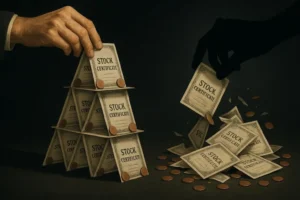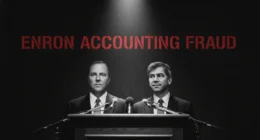The glittering lie of fast money
It always starts with a whisper.
A “hot tip.”
A stock trading under a dollar.
A promise that it’s about to “explode.” That’s how penny stock pump and dump scams pull you in. The setup is simple. The deception is not.
In the 1990s, Jordan Belfort — the infamous Wolf of Wall Street — turned this trick into an empire. His firm, Stratton Oakmont, scammed investors for over $200 million before collapsing in 1996.
But here’s the real horror: the game didn’t die with him. It only evolved.
How the “pump” begins
Scammers pick a tiny stock — a company no one’s heard of.
It trades for pennies. Thin volume. Weak oversight.
Then the pumping starts.
Cold calls. Social media posts. Fake newsletters. Paid YouTube “analysts.”
Everywhere you look, someone says, “This stock will 10x by next week.”
The price rises as new investors pile in.
Their hope becomes the bait.
And when the price peaks — when the crowd is drunk on greed — the wolves dump everything.
The price crashes.
The dream dies.
The victims are left with worthless paper and empty accounts.
In 2023 alone, U.S. regulators uncovered 198 major pump-and-dump operations, draining over $4.3 billion from retail investors.

The teacher and the tip
Karen, 47, was a schoolteacher from Ohio. She wasn’t a gambler. But she wanted to grow her retirement savings.
In a Facebook trading group, a man called “Mark” shared a stock called Biomaxx Therapeutics, trading at $0.38. He said insiders were “loading up.” He claimed it would hit $5 within a month.
Karen invested $12,000 — her summer savings and part of her 401(k).
The price shot to $1.60 in ten days. She couldn’t believe it. She told her friends. She even convinced her brother to join.
Then, suddenly, the stock plummeted. $1.60… $0.90… $0.10… $0.01.
She tried to sell. The broker’s system froze. Then her account balance showed $87.
Karen cried for weeks. She told me it felt like watching her life “drain down a digital sinkhole.”
She later learned that “Mark” was part of a Telegram ring that had pumped over 50 stocks using fake influencer accounts.
The new wolves wear hoodies
Once, the wolves wore suits and slick hair. Now, they wear hoodies and run Discord servers.
They call it “community trading.” But it’s the same game.
Only faster. Louder. Global.
In 2021, the SEC charged several social media influencers who coordinated to pump stocks through Twitter and YouTube. They lured followers into buying and secretly sold their own shares at the top.
One influencer bragged about making $10 million in a week. His followers lost everything.
The tools have changed. The greed hasn’t.
The crypto crossover
Luis, 29, from Manila, started trading penny stocks after losing money in crypto.
He joined a Discord channel claiming to “recover losses through micro-cap plays.” The admins shared daily “buy alerts” for obscure U.S. OTC stocks.
Luis followed blindly. He made small wins at first — $200, $500. Then came NovaTech Pharma. It was “about to explode,” they said.
He borrowed $8,000 from friends and jumped in.
Two days later, the stock crashed 93%. The admins disappeared. The channel was deleted.
Luis told his mother he was “fine,” but he stopped answering calls for weeks.
He said it felt like being “robbed in slow motion.”
According to FINRA, more than 37,000 victims reported similar “micro-cap manipulation” between 2020 and 2023.
Why penny stock scams never die
Because greed never dies.
And fear keeps people quiet.
There are five reasons this plague survives:
• Low regulation. OTC markets remain lightly policed. Many penny stocks skip SEC filings.
• Easy anonymity. Scammers hide behind fake IPs and offshore brokers.
• Cheap shares. Even small pumps make big percentages.
• Social media amplification. Platforms spread hype faster than regulators can react.
• Victim silence. Most are too embarrassed to report losses.
Even after Stratton Oakmont collapsed, copycats sprang up overnight. Some ex-brokers simply rebranded and continued abroad.

How to spot the setup
If you see these signs, run:
• Unrealistic returns (“300% in two weeks!”)
• Unverified “insider” news
• Heavy promotion from unknown influencers
• Low-volume stocks suddenly trending online
• Difficulty selling or withdrawing funds
Real investments don’t beg for attention.
Frauds do.
The lasting horror
Every scam leaves ghosts.
Karen still can’t look at her bank app without nausea.
Luis refuses to talk about “investing” ever again.
Their stories echo millions of others — ordinary people seduced by the same old lie: that you can beat the market if you just trust the right stranger.
But here’s the truth — the stranger is the trap.
The modern penny stock pump and dump is not a story from the ’90s. It’s a living monster, wearing the same smile, selling the same fantasy.
If you hear the whisper — “It’s a sure thing” — that’s not opportunity calling.
It’s the wolf.
Final warning
The next “hot stock” you see on Reddit or X might not be a miracle. It might be a setup.
Remember this: if they need your excitement to make money, you’re the product.
Stay skeptical. Stay safe.
Because in the world of penny stocks, the real profit comes from your loss.
Resources
[3] SEC.gov “Social Media and Stock Tip Scams – Investor Alert”
[6] U.S. Securities and Exchange Commission. “Over-the-Counter Securities
[7]Five Individuals Indicted for Long-Running Pump-and-Dump Schemes
Related reading (suggested)
Binary Options Fraud: Israel’s $10 Billion Scam Industry Exposed
Forex Trading Scams: Why 95% of Forex Courses Are Fraudulent










